Money Laundering and Banks: Malaysian AML Laws and Policies Report
VerifiedAdded on 2021/04/17
|11
|2376
|42
Report
AI Summary
This report provides a comprehensive analysis of money laundering, its mechanisms, and its impact on financial institutions, particularly banks. It begins with an introduction to money laundering, including its definition, types, and background. The report then delves into the stages and mechanisms of money laundering, followed by a specific focus on financial institutions in Malaysia and the country's anti-money laundering methods. A significant portion of the report is dedicated to the Malaysian AML laws, including the Anti-Money Laundering and Anti-Terrorism Financing Act (AMLATFA), the role of the National Coordination Committee, and the Mutual Assistance in Criminal Matters Act (MACMA). The report further assesses the impact of these laws on financial intermediaries. A critical comparative analysis of anti-money laundering processes in Malaysia, Australia, and the United Kingdom is presented, including the money laundering policies in each country. The report concludes with a summary of the key findings and implications of the research.

Running head: MONEY LAUNDERING AND BANKS
Financial Report
Name of the Student
Name of the University
Author Note
Financial Report
Name of the Student
Name of the University
Author Note
Paraphrase This Document
Need a fresh take? Get an instant paraphrase of this document with our AI Paraphraser
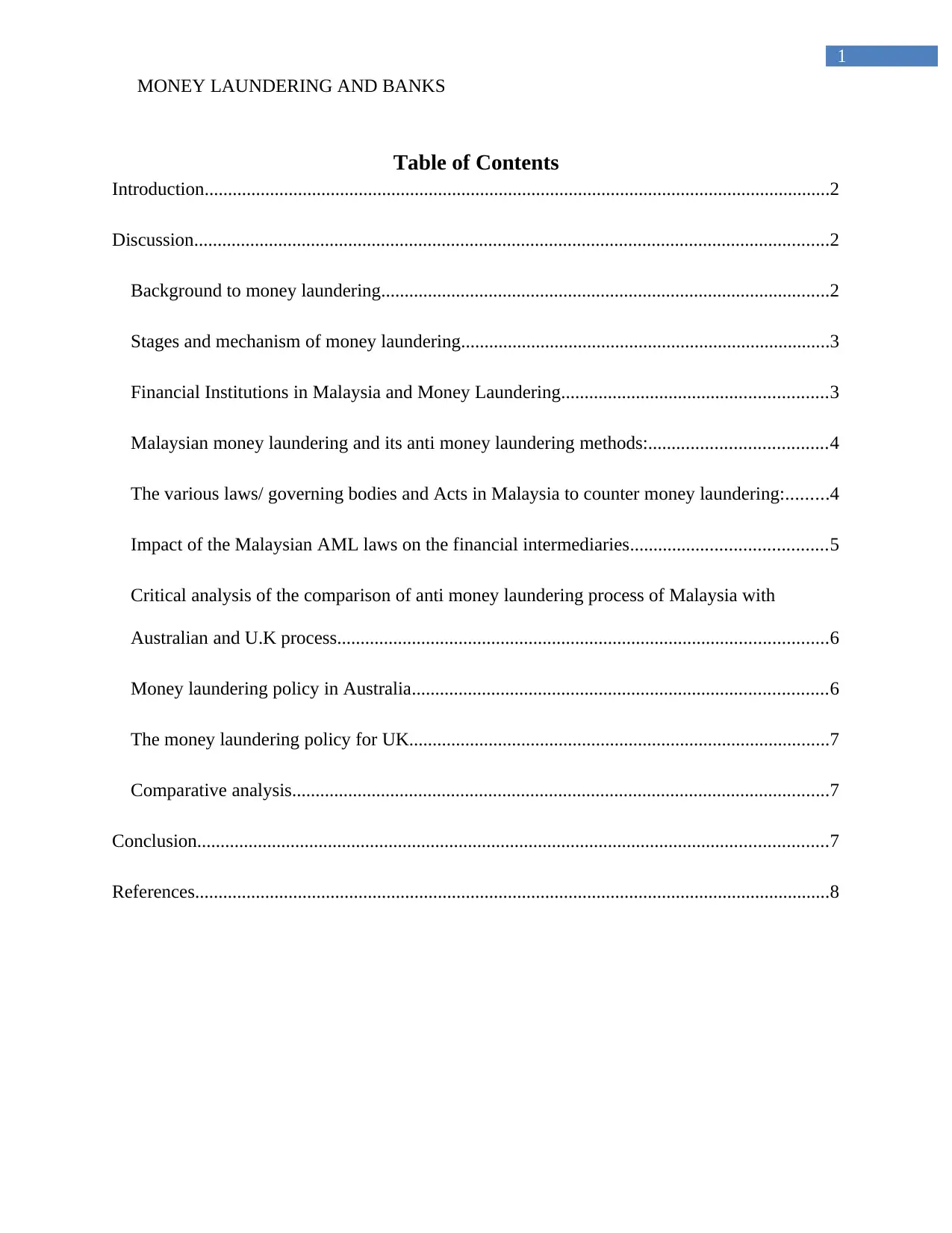
1
MONEY LAUNDERING AND BANKS
Table of Contents
Introduction......................................................................................................................................2
Discussion........................................................................................................................................2
Background to money laundering................................................................................................2
Stages and mechanism of money laundering...............................................................................3
Financial Institutions in Malaysia and Money Laundering.........................................................3
Malaysian money laundering and its anti money laundering methods:......................................4
The various laws/ governing bodies and Acts in Malaysia to counter money laundering:.........4
Impact of the Malaysian AML laws on the financial intermediaries..........................................5
Critical analysis of the comparison of anti money laundering process of Malaysia with
Australian and U.K process.........................................................................................................6
Money laundering policy in Australia.........................................................................................6
The money laundering policy for UK..........................................................................................7
Comparative analysis...................................................................................................................7
Conclusion.......................................................................................................................................7
References........................................................................................................................................8
MONEY LAUNDERING AND BANKS
Table of Contents
Introduction......................................................................................................................................2
Discussion........................................................................................................................................2
Background to money laundering................................................................................................2
Stages and mechanism of money laundering...............................................................................3
Financial Institutions in Malaysia and Money Laundering.........................................................3
Malaysian money laundering and its anti money laundering methods:......................................4
The various laws/ governing bodies and Acts in Malaysia to counter money laundering:.........4
Impact of the Malaysian AML laws on the financial intermediaries..........................................5
Critical analysis of the comparison of anti money laundering process of Malaysia with
Australian and U.K process.........................................................................................................6
Money laundering policy in Australia.........................................................................................6
The money laundering policy for UK..........................................................................................7
Comparative analysis...................................................................................................................7
Conclusion.......................................................................................................................................7
References........................................................................................................................................8
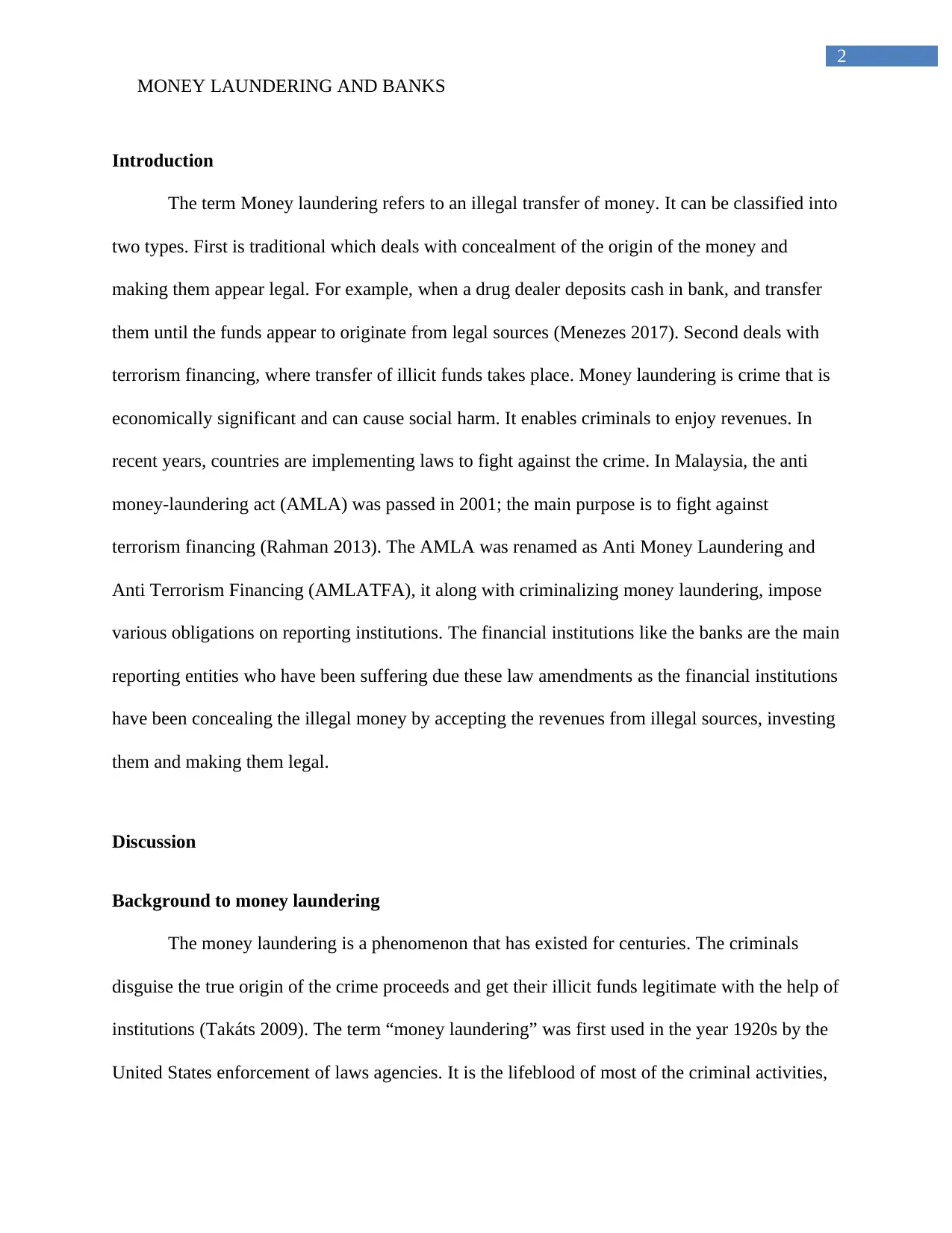
2
MONEY LAUNDERING AND BANKS
Introduction
The term Money laundering refers to an illegal transfer of money. It can be classified into
two types. First is traditional which deals with concealment of the origin of the money and
making them appear legal. For example, when a drug dealer deposits cash in bank, and transfer
them until the funds appear to originate from legal sources (Menezes 2017). Second deals with
terrorism financing, where transfer of illicit funds takes place. Money laundering is crime that is
economically significant and can cause social harm. It enables criminals to enjoy revenues. In
recent years, countries are implementing laws to fight against the crime. In Malaysia, the anti
money-laundering act (AMLA) was passed in 2001; the main purpose is to fight against
terrorism financing (Rahman 2013). The AMLA was renamed as Anti Money Laundering and
Anti Terrorism Financing (AMLATFA), it along with criminalizing money laundering, impose
various obligations on reporting institutions. The financial institutions like the banks are the main
reporting entities who have been suffering due these law amendments as the financial institutions
have been concealing the illegal money by accepting the revenues from illegal sources, investing
them and making them legal.
Discussion
Background to money laundering
The money laundering is a phenomenon that has existed for centuries. The criminals
disguise the true origin of the crime proceeds and get their illicit funds legitimate with the help of
institutions (Takáts 2009). The term “money laundering” was first used in the year 1920s by the
United States enforcement of laws agencies. It is the lifeblood of most of the criminal activities,
MONEY LAUNDERING AND BANKS
Introduction
The term Money laundering refers to an illegal transfer of money. It can be classified into
two types. First is traditional which deals with concealment of the origin of the money and
making them appear legal. For example, when a drug dealer deposits cash in bank, and transfer
them until the funds appear to originate from legal sources (Menezes 2017). Second deals with
terrorism financing, where transfer of illicit funds takes place. Money laundering is crime that is
economically significant and can cause social harm. It enables criminals to enjoy revenues. In
recent years, countries are implementing laws to fight against the crime. In Malaysia, the anti
money-laundering act (AMLA) was passed in 2001; the main purpose is to fight against
terrorism financing (Rahman 2013). The AMLA was renamed as Anti Money Laundering and
Anti Terrorism Financing (AMLATFA), it along with criminalizing money laundering, impose
various obligations on reporting institutions. The financial institutions like the banks are the main
reporting entities who have been suffering due these law amendments as the financial institutions
have been concealing the illegal money by accepting the revenues from illegal sources, investing
them and making them legal.
Discussion
Background to money laundering
The money laundering is a phenomenon that has existed for centuries. The criminals
disguise the true origin of the crime proceeds and get their illicit funds legitimate with the help of
institutions (Takáts 2009). The term “money laundering” was first used in the year 1920s by the
United States enforcement of laws agencies. It is the lifeblood of most of the criminal activities,
⊘ This is a preview!⊘
Do you want full access?
Subscribe today to unlock all pages.

Trusted by 1+ million students worldwide
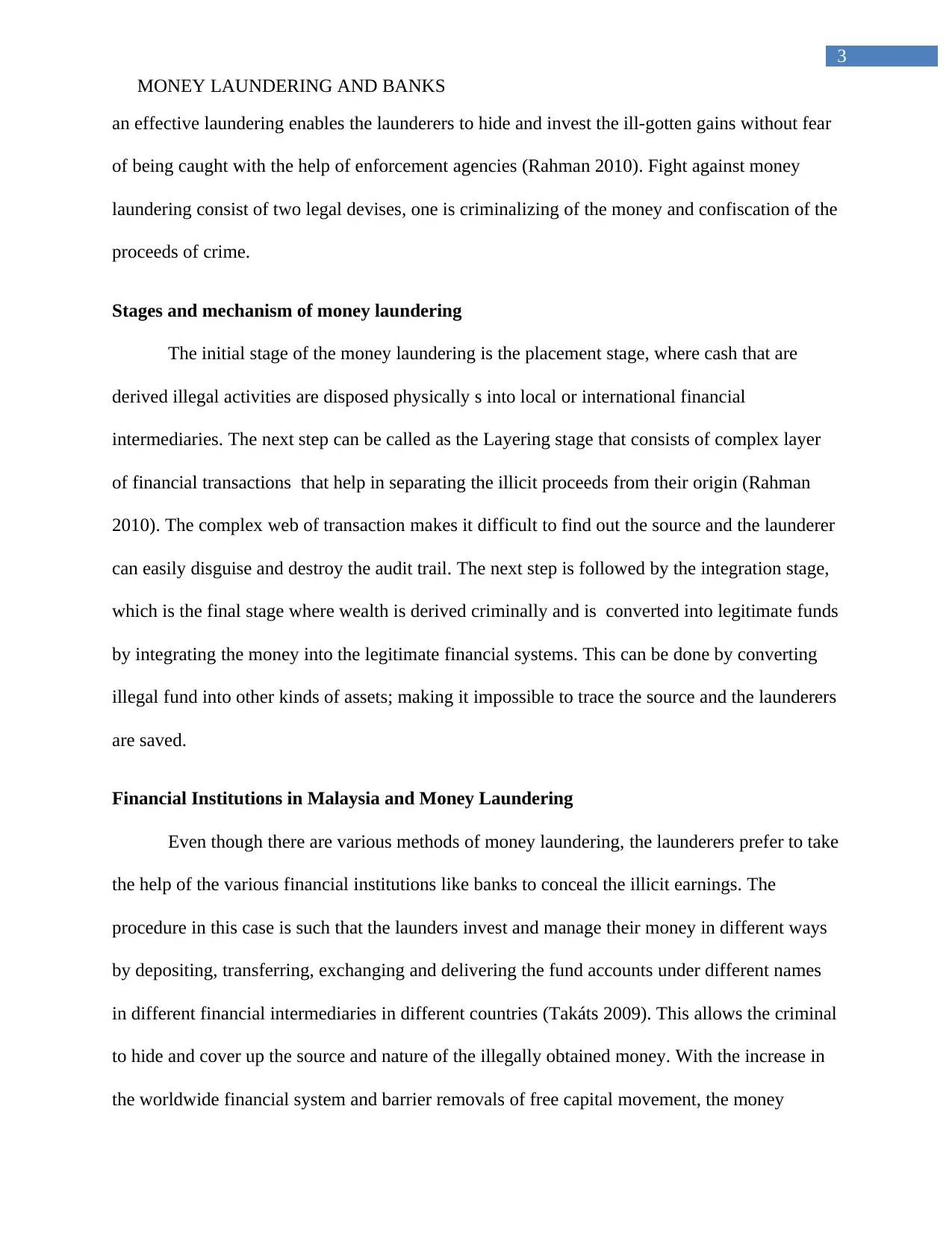
3
MONEY LAUNDERING AND BANKS
an effective laundering enables the launderers to hide and invest the ill-gotten gains without fear
of being caught with the help of enforcement agencies (Rahman 2010). Fight against money
laundering consist of two legal devises, one is criminalizing of the money and confiscation of the
proceeds of crime.
Stages and mechanism of money laundering
The initial stage of the money laundering is the placement stage, where cash that are
derived illegal activities are disposed physically s into local or international financial
intermediaries. The next step can be called as the Layering stage that consists of complex layer
of financial transactions that help in separating the illicit proceeds from their origin (Rahman
2010). The complex web of transaction makes it difficult to find out the source and the launderer
can easily disguise and destroy the audit trail. The next step is followed by the integration stage,
which is the final stage where wealth is derived criminally and is converted into legitimate funds
by integrating the money into the legitimate financial systems. This can be done by converting
illegal fund into other kinds of assets; making it impossible to trace the source and the launderers
are saved.
Financial Institutions in Malaysia and Money Laundering
Even though there are various methods of money laundering, the launderers prefer to take
the help of the various financial institutions like banks to conceal the illicit earnings. The
procedure in this case is such that the launders invest and manage their money in different ways
by depositing, transferring, exchanging and delivering the fund accounts under different names
in different financial intermediaries in different countries (Takáts 2009). This allows the criminal
to hide and cover up the source and nature of the illegally obtained money. With the increase in
the worldwide financial system and barrier removals of free capital movement, the money
MONEY LAUNDERING AND BANKS
an effective laundering enables the launderers to hide and invest the ill-gotten gains without fear
of being caught with the help of enforcement agencies (Rahman 2010). Fight against money
laundering consist of two legal devises, one is criminalizing of the money and confiscation of the
proceeds of crime.
Stages and mechanism of money laundering
The initial stage of the money laundering is the placement stage, where cash that are
derived illegal activities are disposed physically s into local or international financial
intermediaries. The next step can be called as the Layering stage that consists of complex layer
of financial transactions that help in separating the illicit proceeds from their origin (Rahman
2010). The complex web of transaction makes it difficult to find out the source and the launderer
can easily disguise and destroy the audit trail. The next step is followed by the integration stage,
which is the final stage where wealth is derived criminally and is converted into legitimate funds
by integrating the money into the legitimate financial systems. This can be done by converting
illegal fund into other kinds of assets; making it impossible to trace the source and the launderers
are saved.
Financial Institutions in Malaysia and Money Laundering
Even though there are various methods of money laundering, the launderers prefer to take
the help of the various financial institutions like banks to conceal the illicit earnings. The
procedure in this case is such that the launders invest and manage their money in different ways
by depositing, transferring, exchanging and delivering the fund accounts under different names
in different financial intermediaries in different countries (Takáts 2009). This allows the criminal
to hide and cover up the source and nature of the illegally obtained money. With the increase in
the worldwide financial system and barrier removals of free capital movement, the money
Paraphrase This Document
Need a fresh take? Get an instant paraphrase of this document with our AI Paraphraser
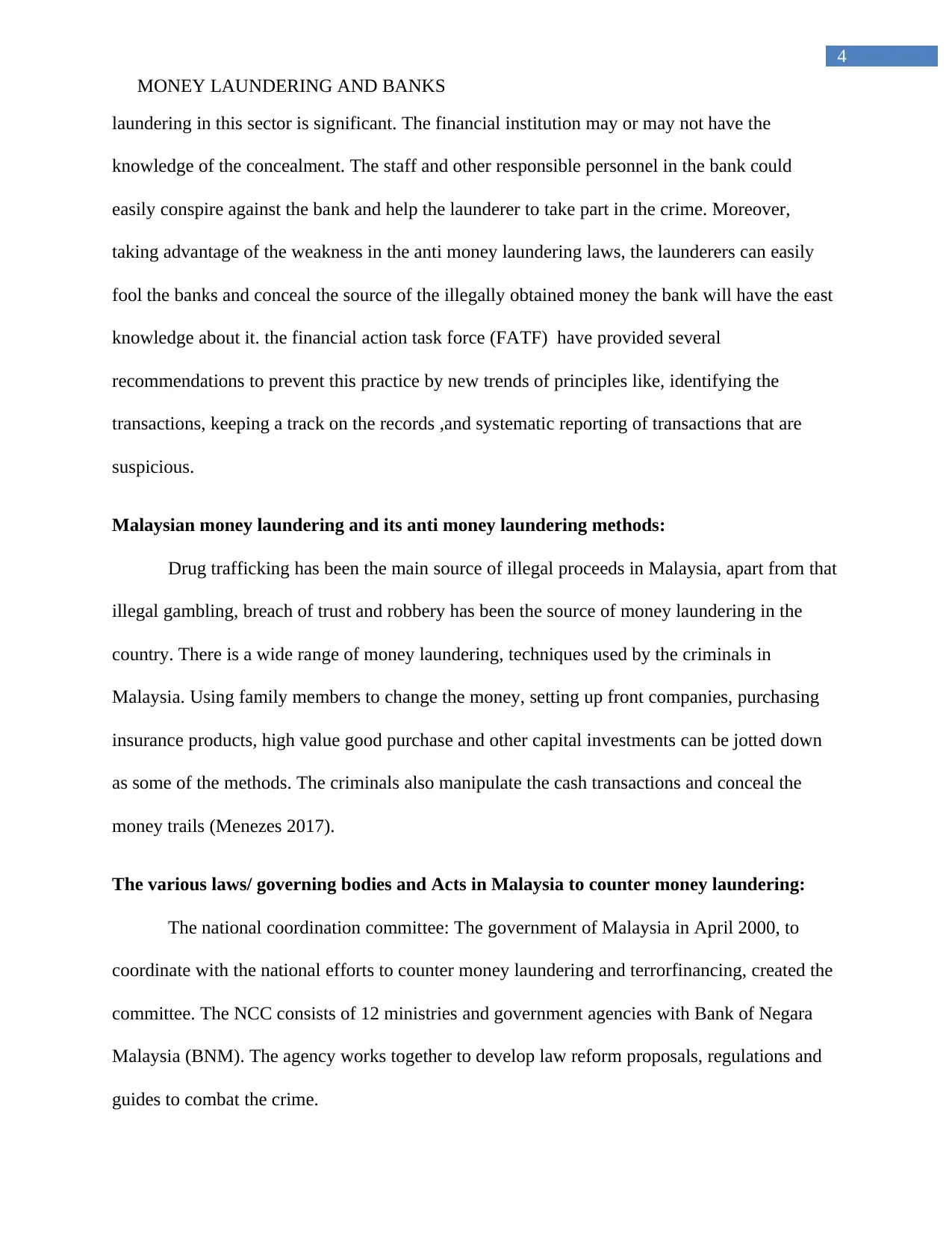
4
MONEY LAUNDERING AND BANKS
laundering in this sector is significant. The financial institution may or may not have the
knowledge of the concealment. The staff and other responsible personnel in the bank could
easily conspire against the bank and help the launderer to take part in the crime. Moreover,
taking advantage of the weakness in the anti money laundering laws, the launderers can easily
fool the banks and conceal the source of the illegally obtained money the bank will have the east
knowledge about it. the financial action task force (FATF) have provided several
recommendations to prevent this practice by new trends of principles like, identifying the
transactions, keeping a track on the records ,and systematic reporting of transactions that are
suspicious.
Malaysian money laundering and its anti money laundering methods:
Drug trafficking has been the main source of illegal proceeds in Malaysia, apart from that
illegal gambling, breach of trust and robbery has been the source of money laundering in the
country. There is a wide range of money laundering, techniques used by the criminals in
Malaysia. Using family members to change the money, setting up front companies, purchasing
insurance products, high value good purchase and other capital investments can be jotted down
as some of the methods. The criminals also manipulate the cash transactions and conceal the
money trails (Menezes 2017).
The various laws/ governing bodies and Acts in Malaysia to counter money laundering:
The national coordination committee: The government of Malaysia in April 2000, to
coordinate with the national efforts to counter money laundering and terrorfinancing, created the
committee. The NCC consists of 12 ministries and government agencies with Bank of Negara
Malaysia (BNM). The agency works together to develop law reform proposals, regulations and
guides to combat the crime.
MONEY LAUNDERING AND BANKS
laundering in this sector is significant. The financial institution may or may not have the
knowledge of the concealment. The staff and other responsible personnel in the bank could
easily conspire against the bank and help the launderer to take part in the crime. Moreover,
taking advantage of the weakness in the anti money laundering laws, the launderers can easily
fool the banks and conceal the source of the illegally obtained money the bank will have the east
knowledge about it. the financial action task force (FATF) have provided several
recommendations to prevent this practice by new trends of principles like, identifying the
transactions, keeping a track on the records ,and systematic reporting of transactions that are
suspicious.
Malaysian money laundering and its anti money laundering methods:
Drug trafficking has been the main source of illegal proceeds in Malaysia, apart from that
illegal gambling, breach of trust and robbery has been the source of money laundering in the
country. There is a wide range of money laundering, techniques used by the criminals in
Malaysia. Using family members to change the money, setting up front companies, purchasing
insurance products, high value good purchase and other capital investments can be jotted down
as some of the methods. The criminals also manipulate the cash transactions and conceal the
money trails (Menezes 2017).
The various laws/ governing bodies and Acts in Malaysia to counter money laundering:
The national coordination committee: The government of Malaysia in April 2000, to
coordinate with the national efforts to counter money laundering and terrorfinancing, created the
committee. The NCC consists of 12 ministries and government agencies with Bank of Negara
Malaysia (BNM). The agency works together to develop law reform proposals, regulations and
guides to combat the crime.
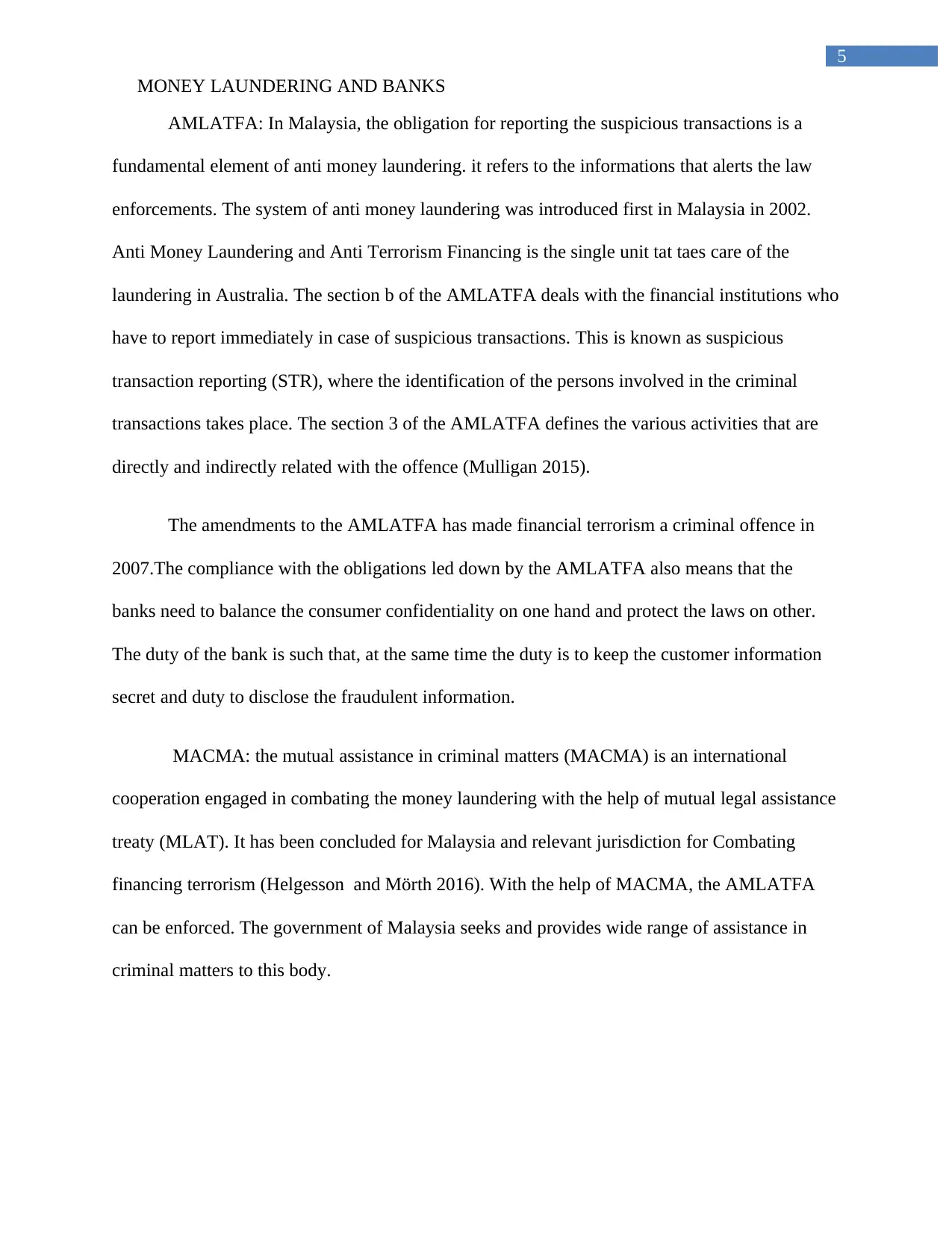
5
MONEY LAUNDERING AND BANKS
AMLATFA: In Malaysia, the obligation for reporting the suspicious transactions is a
fundamental element of anti money laundering. it refers to the informations that alerts the law
enforcements. The system of anti money laundering was introduced first in Malaysia in 2002.
Anti Money Laundering and Anti Terrorism Financing is the single unit tat taes care of the
laundering in Australia. The section b of the AMLATFA deals with the financial institutions who
have to report immediately in case of suspicious transactions. This is known as suspicious
transaction reporting (STR), where the identification of the persons involved in the criminal
transactions takes place. The section 3 of the AMLATFA defines the various activities that are
directly and indirectly related with the offence (Mulligan 2015).
The amendments to the AMLATFA has made financial terrorism a criminal offence in
2007.The compliance with the obligations led down by the AMLATFA also means that the
banks need to balance the consumer confidentiality on one hand and protect the laws on other.
The duty of the bank is such that, at the same time the duty is to keep the customer information
secret and duty to disclose the fraudulent information.
MACMA: the mutual assistance in criminal matters (MACMA) is an international
cooperation engaged in combating the money laundering with the help of mutual legal assistance
treaty (MLAT). It has been concluded for Malaysia and relevant jurisdiction for Combating
financing terrorism (Helgesson and Mörth 2016). With the help of MACMA, the AMLATFA
can be enforced. The government of Malaysia seeks and provides wide range of assistance in
criminal matters to this body.
MONEY LAUNDERING AND BANKS
AMLATFA: In Malaysia, the obligation for reporting the suspicious transactions is a
fundamental element of anti money laundering. it refers to the informations that alerts the law
enforcements. The system of anti money laundering was introduced first in Malaysia in 2002.
Anti Money Laundering and Anti Terrorism Financing is the single unit tat taes care of the
laundering in Australia. The section b of the AMLATFA deals with the financial institutions who
have to report immediately in case of suspicious transactions. This is known as suspicious
transaction reporting (STR), where the identification of the persons involved in the criminal
transactions takes place. The section 3 of the AMLATFA defines the various activities that are
directly and indirectly related with the offence (Mulligan 2015).
The amendments to the AMLATFA has made financial terrorism a criminal offence in
2007.The compliance with the obligations led down by the AMLATFA also means that the
banks need to balance the consumer confidentiality on one hand and protect the laws on other.
The duty of the bank is such that, at the same time the duty is to keep the customer information
secret and duty to disclose the fraudulent information.
MACMA: the mutual assistance in criminal matters (MACMA) is an international
cooperation engaged in combating the money laundering with the help of mutual legal assistance
treaty (MLAT). It has been concluded for Malaysia and relevant jurisdiction for Combating
financing terrorism (Helgesson and Mörth 2016). With the help of MACMA, the AMLATFA
can be enforced. The government of Malaysia seeks and provides wide range of assistance in
criminal matters to this body.
⊘ This is a preview!⊘
Do you want full access?
Subscribe today to unlock all pages.

Trusted by 1+ million students worldwide
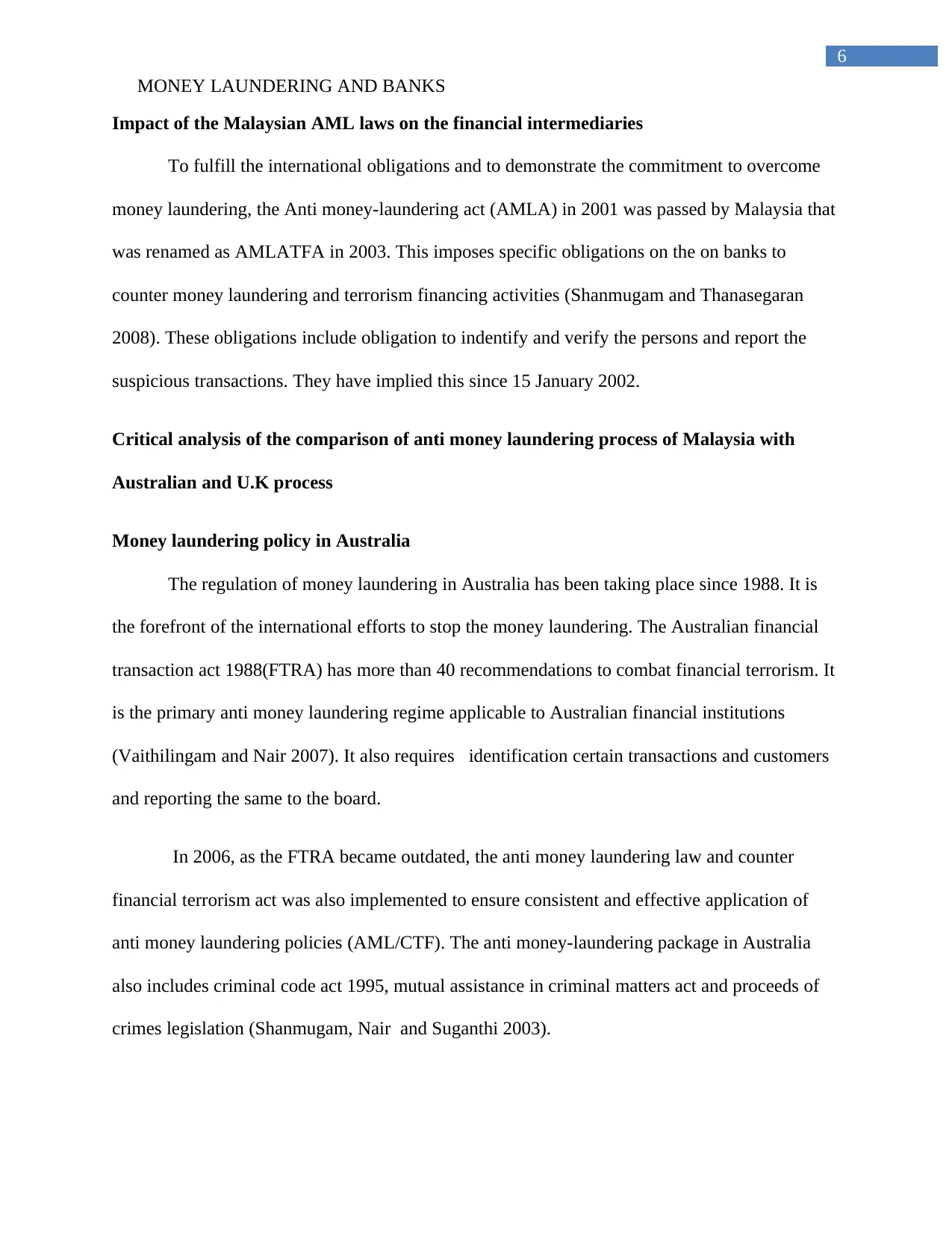
6
MONEY LAUNDERING AND BANKS
Impact of the Malaysian AML laws on the financial intermediaries
To fulfill the international obligations and to demonstrate the commitment to overcome
money laundering, the Anti money-laundering act (AMLA) in 2001 was passed by Malaysia that
was renamed as AMLATFA in 2003. This imposes specific obligations on the on banks to
counter money laundering and terrorism financing activities (Shanmugam and Thanasegaran
2008). These obligations include obligation to indentify and verify the persons and report the
suspicious transactions. They have implied this since 15 January 2002.
Critical analysis of the comparison of anti money laundering process of Malaysia with
Australian and U.K process
Money laundering policy in Australia
The regulation of money laundering in Australia has been taking place since 1988. It is
the forefront of the international efforts to stop the money laundering. The Australian financial
transaction act 1988(FTRA) has more than 40 recommendations to combat financial terrorism. It
is the primary anti money laundering regime applicable to Australian financial institutions
(Vaithilingam and Nair 2007). It also requires identification certain transactions and customers
and reporting the same to the board.
In 2006, as the FTRA became outdated, the anti money laundering law and counter
financial terrorism act was also implemented to ensure consistent and effective application of
anti money laundering policies (AML/CTF). The anti money-laundering package in Australia
also includes criminal code act 1995, mutual assistance in criminal matters act and proceeds of
crimes legislation (Shanmugam, Nair and Suganthi 2003).
MONEY LAUNDERING AND BANKS
Impact of the Malaysian AML laws on the financial intermediaries
To fulfill the international obligations and to demonstrate the commitment to overcome
money laundering, the Anti money-laundering act (AMLA) in 2001 was passed by Malaysia that
was renamed as AMLATFA in 2003. This imposes specific obligations on the on banks to
counter money laundering and terrorism financing activities (Shanmugam and Thanasegaran
2008). These obligations include obligation to indentify and verify the persons and report the
suspicious transactions. They have implied this since 15 January 2002.
Critical analysis of the comparison of anti money laundering process of Malaysia with
Australian and U.K process
Money laundering policy in Australia
The regulation of money laundering in Australia has been taking place since 1988. It is
the forefront of the international efforts to stop the money laundering. The Australian financial
transaction act 1988(FTRA) has more than 40 recommendations to combat financial terrorism. It
is the primary anti money laundering regime applicable to Australian financial institutions
(Vaithilingam and Nair 2007). It also requires identification certain transactions and customers
and reporting the same to the board.
In 2006, as the FTRA became outdated, the anti money laundering law and counter
financial terrorism act was also implemented to ensure consistent and effective application of
anti money laundering policies (AML/CTF). The anti money-laundering package in Australia
also includes criminal code act 1995, mutual assistance in criminal matters act and proceeds of
crimes legislation (Shanmugam, Nair and Suganthi 2003).
Paraphrase This Document
Need a fresh take? Get an instant paraphrase of this document with our AI Paraphraser
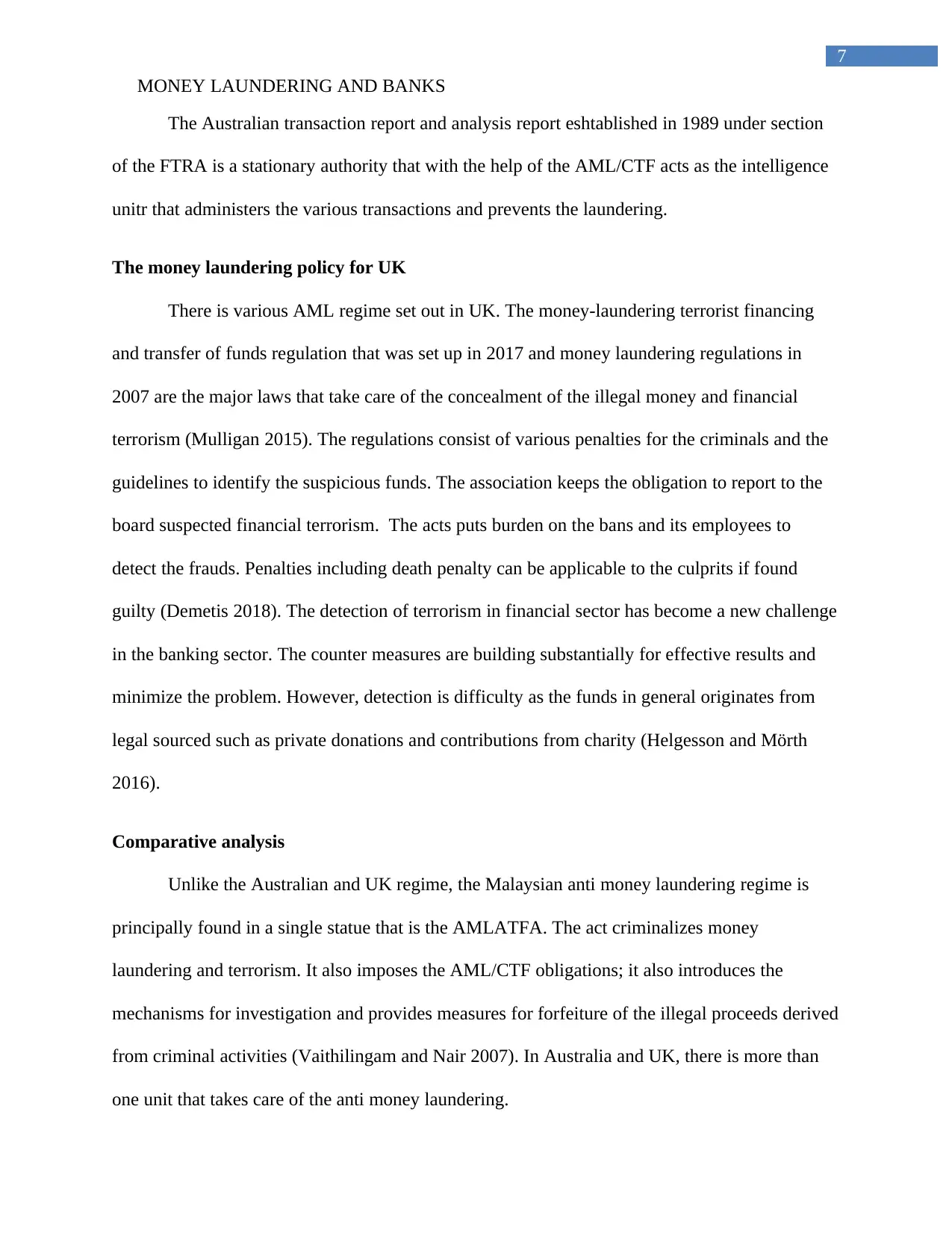
7
MONEY LAUNDERING AND BANKS
The Australian transaction report and analysis report eshtablished in 1989 under section
of the FTRA is a stationary authority that with the help of the AML/CTF acts as the intelligence
unitr that administers the various transactions and prevents the laundering.
The money laundering policy for UK
There is various AML regime set out in UK. The money-laundering terrorist financing
and transfer of funds regulation that was set up in 2017 and money laundering regulations in
2007 are the major laws that take care of the concealment of the illegal money and financial
terrorism (Mulligan 2015). The regulations consist of various penalties for the criminals and the
guidelines to identify the suspicious funds. The association keeps the obligation to report to the
board suspected financial terrorism. The acts puts burden on the bans and its employees to
detect the frauds. Penalties including death penalty can be applicable to the culprits if found
guilty (Demetis 2018). The detection of terrorism in financial sector has become a new challenge
in the banking sector. The counter measures are building substantially for effective results and
minimize the problem. However, detection is difficulty as the funds in general originates from
legal sourced such as private donations and contributions from charity (Helgesson and Mörth
2016).
Comparative analysis
Unlike the Australian and UK regime, the Malaysian anti money laundering regime is
principally found in a single statue that is the AMLATFA. The act criminalizes money
laundering and terrorism. It also imposes the AML/CTF obligations; it also introduces the
mechanisms for investigation and provides measures for forfeiture of the illegal proceeds derived
from criminal activities (Vaithilingam and Nair 2007). In Australia and UK, there is more than
one unit that takes care of the anti money laundering.
MONEY LAUNDERING AND BANKS
The Australian transaction report and analysis report eshtablished in 1989 under section
of the FTRA is a stationary authority that with the help of the AML/CTF acts as the intelligence
unitr that administers the various transactions and prevents the laundering.
The money laundering policy for UK
There is various AML regime set out in UK. The money-laundering terrorist financing
and transfer of funds regulation that was set up in 2017 and money laundering regulations in
2007 are the major laws that take care of the concealment of the illegal money and financial
terrorism (Mulligan 2015). The regulations consist of various penalties for the criminals and the
guidelines to identify the suspicious funds. The association keeps the obligation to report to the
board suspected financial terrorism. The acts puts burden on the bans and its employees to
detect the frauds. Penalties including death penalty can be applicable to the culprits if found
guilty (Demetis 2018). The detection of terrorism in financial sector has become a new challenge
in the banking sector. The counter measures are building substantially for effective results and
minimize the problem. However, detection is difficulty as the funds in general originates from
legal sourced such as private donations and contributions from charity (Helgesson and Mörth
2016).
Comparative analysis
Unlike the Australian and UK regime, the Malaysian anti money laundering regime is
principally found in a single statue that is the AMLATFA. The act criminalizes money
laundering and terrorism. It also imposes the AML/CTF obligations; it also introduces the
mechanisms for investigation and provides measures for forfeiture of the illegal proceeds derived
from criminal activities (Vaithilingam and Nair 2007). In Australia and UK, there is more than
one unit that takes care of the anti money laundering.

8
MONEY LAUNDERING AND BANKS
Conclusion
The different countries have different techniques of money laundering. The last few years
have witnessed various fundamental changes in the legal and regulatory environment relating to
AML. The discussion vividly shows the laws adapted by the Malaysian banks and other financial
intermediaries to combat the financial terrorism. There has been a increase in the regulations and
guidelines in terms of AML. The Malaysian anti money laundering regime is principally found
in a single statue that is the AMLATFA, whereas UK and Australia has more than one governing
bodies taking care of money laundering.
MONEY LAUNDERING AND BANKS
Conclusion
The different countries have different techniques of money laundering. The last few years
have witnessed various fundamental changes in the legal and regulatory environment relating to
AML. The discussion vividly shows the laws adapted by the Malaysian banks and other financial
intermediaries to combat the financial terrorism. There has been a increase in the regulations and
guidelines in terms of AML. The Malaysian anti money laundering regime is principally found
in a single statue that is the AMLATFA, whereas UK and Australia has more than one governing
bodies taking care of money laundering.
⊘ This is a preview!⊘
Do you want full access?
Subscribe today to unlock all pages.

Trusted by 1+ million students worldwide

9
MONEY LAUNDERING AND BANKS
References
Demetis, D.S., 2018. Fighting money laundering with technology: A case study of Bank X in the
UK. Decision Support Systems, 105, pp.96-107.
Helgesson, K.S. and Mörth, U., 2016. Involuntary Public Policy‐making by For‐Profit
Professionals: European Lawyers on Anti‐Money Laundering and Terrorism Financing. JCMS:
Journal of Common Market Studies, 54(5), pp.1216-1232.
Menezes, K.P., 2017. To what extent has money laundering affected Financial Institutions and
how to mitigate the risks associated with it: A case study of EmiratesNBD (Doctoral dissertation,
Cardiff Metropolitan University).
Mulligan, E.M., 2015. Evaluating the Social Control of Banking Crimes: An Examination of
Anti-Money Laundering Deficiencies and Industry Success.
Rahman, A.A., 2010. An Analysis of the Malaysian Anti-money Laundering Laws and their
Impact on Banking Institutions. VDM Publishing.
Rahman, A.A., 2013. The impact of reporting suspicious transactions regime on banks:
Malaysian experience. Journal of Money Laundering Control, 16(2), pp.159-170.
Shanmugam, B. and Thanasegaran, H., 2008. Combating money laundering in Malaysia. Journal
of Money Laundering Control, 11(4), pp.331-344.
Shanmugam, B., Nair, M. and Suganthi, R., 2003. Money laundering in Malaysia. Journal of
Money Laundering Control, 6(4), pp.373-378.
MONEY LAUNDERING AND BANKS
References
Demetis, D.S., 2018. Fighting money laundering with technology: A case study of Bank X in the
UK. Decision Support Systems, 105, pp.96-107.
Helgesson, K.S. and Mörth, U., 2016. Involuntary Public Policy‐making by For‐Profit
Professionals: European Lawyers on Anti‐Money Laundering and Terrorism Financing. JCMS:
Journal of Common Market Studies, 54(5), pp.1216-1232.
Menezes, K.P., 2017. To what extent has money laundering affected Financial Institutions and
how to mitigate the risks associated with it: A case study of EmiratesNBD (Doctoral dissertation,
Cardiff Metropolitan University).
Mulligan, E.M., 2015. Evaluating the Social Control of Banking Crimes: An Examination of
Anti-Money Laundering Deficiencies and Industry Success.
Rahman, A.A., 2010. An Analysis of the Malaysian Anti-money Laundering Laws and their
Impact on Banking Institutions. VDM Publishing.
Rahman, A.A., 2013. The impact of reporting suspicious transactions regime on banks:
Malaysian experience. Journal of Money Laundering Control, 16(2), pp.159-170.
Shanmugam, B. and Thanasegaran, H., 2008. Combating money laundering in Malaysia. Journal
of Money Laundering Control, 11(4), pp.331-344.
Shanmugam, B., Nair, M. and Suganthi, R., 2003. Money laundering in Malaysia. Journal of
Money Laundering Control, 6(4), pp.373-378.
Paraphrase This Document
Need a fresh take? Get an instant paraphrase of this document with our AI Paraphraser

10
MONEY LAUNDERING AND BANKS
Takáts, E., 2009. A theory of “Crying Wolf”: The economics of money laundering
enforcement. The Journal of Law, Economics, & Organization, 27(1), pp.32-78.
Vaithilingam, S. and Nair, M., 2007. Factors affecting money laundering: lesson for developing
countries. Journal of Money Laundering Control, 10(3), pp.352-366.
MONEY LAUNDERING AND BANKS
Takáts, E., 2009. A theory of “Crying Wolf”: The economics of money laundering
enforcement. The Journal of Law, Economics, & Organization, 27(1), pp.32-78.
Vaithilingam, S. and Nair, M., 2007. Factors affecting money laundering: lesson for developing
countries. Journal of Money Laundering Control, 10(3), pp.352-366.
1 out of 11
Related Documents
Your All-in-One AI-Powered Toolkit for Academic Success.
+13062052269
info@desklib.com
Available 24*7 on WhatsApp / Email
![[object Object]](/_next/static/media/star-bottom.7253800d.svg)
Unlock your academic potential
Copyright © 2020–2025 A2Z Services. All Rights Reserved. Developed and managed by ZUCOL.





